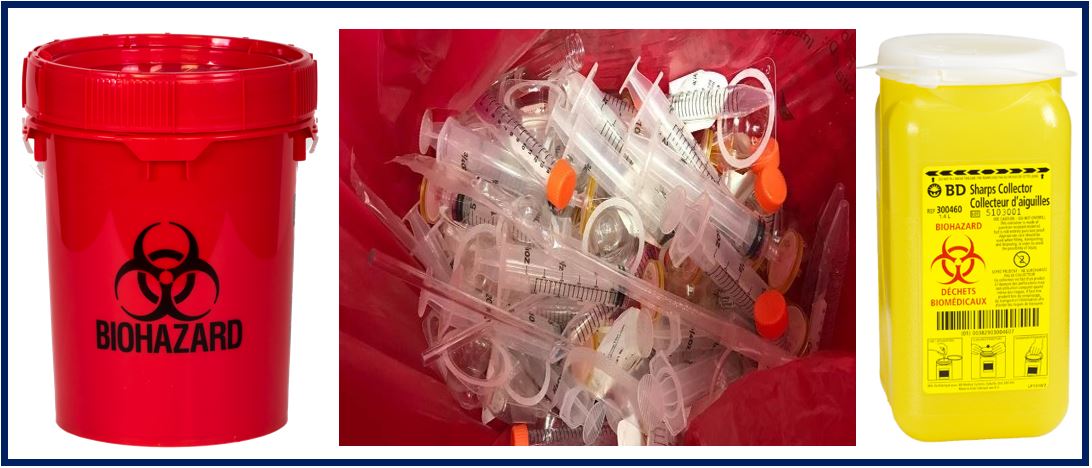Introduction
The first step(of medical waste disposal) is to use the sterilization process. The sterilization process helps to remove all the toxins before it gets contained and sealed for delivery and disposal.
You will run across things like gauze that cannot be disposed of easily. Those materials go through an autoclave. That way you get rid of the toxins and other hazardous elements.
 How much does it cost to dispose of medical waste?
How much does it cost to dispose of medical waste?
Most of the time, medical facilities will(on average) ship out two boxes every month, maybe more depending on the situation. Most companies are going to spend about $40-80 every month to dispose of waste. It could be more depending on the type of waste.
Some of the Common Mistakes People Make With Medical Waste Disposal
Below is a list of some of the common mistakes healthcare workers make with medical waste disposal.
1) Some will mix medical waste with other types of waste (including household items). Medical waste should always be placed in a marked container away from everything else.
You should also refrain from placing medical waste with other containers filled with waste. The two could get mixed accidentally. One of your colleagues might not know the difference. He or she might treat everything the same. That is the last thing you want to happen.
One final thing about the packaging, you should never use a red plastic bag for medical waste. The red bags are for something else.
2) You never multitask when you do something like that. Things like putting on makeup, eating, and drinking should all be done before the disposal.
The reason is you are handling some very serious and dangerous material, even if it is just a small amount. You cannot let other things distract you from doing what is needed.
3) Some will let the liquids leak and think nothing of it. Some will shrug their shoulders thinking it is no big deal. You are dealing with an assortment of things, including other people’s bodily fluids and various intravenous solutions.
The fluids have to be contained during the whole process before they are disposed( that includes transportation and hauling).
4) One thing to note, sharps are not the same as other medical waste. I know many of you like to think they are, but they are not. Sharps have to be handled and disposed of differently(and separately).
Throwing a sharp away(needles and the like) could add to a puncture wound in someone. There is a specifical marker container for sharps. That is where they go. It has a narrow opening and is sealable. One final thing to note about sharps is the idea of breakage. You never(intentionally) break a sharp during waste disposal. Breaking one can cause other issues for someone later.
5) The next common mistake to talk about concerns opening the container. Say, for example, you are dealing with a closed container. Opening one could cause cross-contamination and exposure. A closed container should never be opened for inspection, nor segregation.
Two things
- Medical waste is never segregated into biodegradable and non-biodegradable.
- You never do that after you have sealed it if it is going to happen.
Inspections (if there any to be done) have to be done before you seal it. Inspection is a moot point after the container has been sealed properly.
6) Some people think that using their bare hands is alright. We see that a lot with some of the medical professionals new to the business. It is not. You have to wear protective equipment(PPE) at all times. PPE can include everything from nitrile gloves to full-length gowns( and everything else in between).
7) OSHA(Occupational Safety and Health Administration has strict guidelines on everything here, including this next tip. According to the guidelines, anything that has blood-borne pathogens( which medical waste does)need to be placed in a refrigerator or refrigerated environment to prevent decay.
The refrigerated environment has to be kept separate from all other medical items being refrigerated. Those refrigerated areas have to be designated for biomedical waste. That also means you cannot store food(including your lunch or dinner) there.
8) The next common mistake some people make(though some should know better) is using an unmodified vehicle for transportation. It is illegal to use someone’s regular pickup truck or car to transport the medical waste for disposal.
They use specific vehicles for a reason. It does not matter whether or not your medical waste is a top priority. According to OSHA, you have to use a vehicle modified and designed specifically for use.
The two ways you know it is a modified vehicle are: One, the vehicle comes with a sealed and enclosed compartment for the waste. Two, the lining is non-impregnable. There are bound to be leaks from traveling in certain cases. The lining is there to prevent the leaks from happening and cross-contaminating something else in the vehicle.
9) You cannot just hand over the key to the vehicle and have anyone drive it. Anyone who drives this type of vehicle has to be trained.
Trained professionals go through extensive schooling and education, with particular emphasis on medical waste. No one should drive those vehicles who have not been trained thoroughly.
One Final Note To Add
You have to document everything being transported and disposed of. Documentation must include everything from identifying the waste to the time and date of disposal. Everything has to be accounted for during the process, even the smallest medical waste material. The records have to be updated regularly. Forgetting to document your progress could result in external and internal issues later.
______________________________________________________
Interesting related article: “What is Health?“

